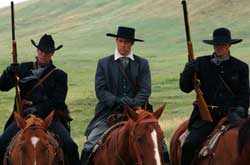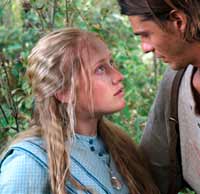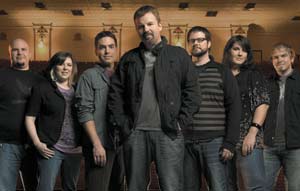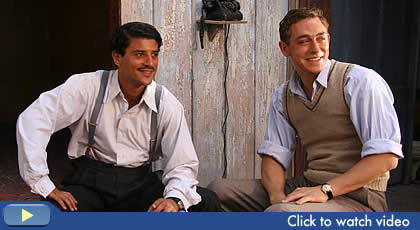 A group of religious fanatics led by a bloodthirsty leader who preaches the violence of “blood atonement” ruthlessly murders a group of peaceful travelers. This, in a sentence, is the plot of “September Dawn”, starring Jon Voight and opening Aug. 24. The year is 1857, the date is Sept. 11, and the killers are Mormons massacring a wagon train of families heading West to California. It’s a tragedy that became known as the Mountain Meadows Massacre, one of the darkest moments in Mormon history, whose details remain shrouded in mystery. Now it’s the subject of a film that, sadly, fails on two fronts: as history and as a movie.
A group of religious fanatics led by a bloodthirsty leader who preaches the violence of “blood atonement” ruthlessly murders a group of peaceful travelers. This, in a sentence, is the plot of “September Dawn”, starring Jon Voight and opening Aug. 24. The year is 1857, the date is Sept. 11, and the killers are Mormons massacring a wagon train of families heading West to California. It’s a tragedy that became known as the Mountain Meadows Massacre, one of the darkest moments in Mormon history, whose details remain shrouded in mystery. Now it’s the subject of a film that, sadly, fails on two fronts: as history and as a movie.
The movie purports to answer one lingering historical question: Was the massacre the work of a renegade group acting on their own, or were they acting on orders from on high–specifically, orders from Brigham Young, the Mormon leader and Utah governor?
In the real world, there’s no scholarly consensus on this question, since the evidence is mostly circumstantial and conjectural. Most historians seem to think Young wasn’t involved, but others make a case that he ordered the bloodshed. (There’s a great overview of the debate here.)
But no need to get into nuances, at least not in this movie.
The Brigham Young of “September Dawn” is shown railing against the “Gentiles”–non-Mormons–and approving the massacre plan. He is depicted as a vengeful, violent leader, but then again, the movie depicts all Mormons as hateful and violent, save one romantic soul who falls in mad, passionate love-at-first-sight with a young woman from the wagon train. The film focuses on their Romeo and Juliet romance, which provides some of the cheesiest and unintentionally laughable moments in a movie full of them.
 In “September Dawn,” the westward wagon train pulls into Utah, then a theocratically-run territory headed by Young. Like the Israelites in the wilderness, they’re looking only to buy provisions and rest for a couple of weeks. The local Mormon leader, Bishop Samuelson (played by Voight), is kind to them until hearing that some of the travelers are from Missouri, where Joseph Smith and many other Mormons were killed. Almost immediately, he turns against them and leaves to seek counsel from Young, leaving his love-struck son to keep an eye on the settlers.
In “September Dawn,” the westward wagon train pulls into Utah, then a theocratically-run territory headed by Young. Like the Israelites in the wilderness, they’re looking only to buy provisions and rest for a couple of weeks. The local Mormon leader, Bishop Samuelson (played by Voight), is kind to them until hearing that some of the travelers are from Missouri, where Joseph Smith and many other Mormons were killed. Almost immediately, he turns against them and leaves to seek counsel from Young, leaving his love-struck son to keep an eye on the settlers.
Stirred up by Samuelson’s preachings, the Mormons are easily whipped into a homicidal frenzy. At one point, the film juxtaposes two pastors–Bishop Samuelson and the wagon-train’s minister–praying at their respective dinner tables. They each start out uttering similar phrases about God and thankfulness. But soon Samuelson’s prayer devolves into a damn-the-Gentiles-to-hell rant that asks God for success in their massacre and curses “these children of Satan,” while the pioneer minister’s prayer remains a let’s-all-get-along ode to peace and brotherly love, thanking the Mormons for their hospitality.
The Mountain Meadows Massacre was obviously a ruthlessly bloody and unforgivably shameful act, and the movie does a decent job of portraying the lambs-to-the-slaughter deaths of the settlers, who believed the Mormons were helping to protect them against the Indians. The pioneers surrendered their weapons to the Mormons and willingly followed them into an open field, making the massacre all the more cowardly and horrific.
Unfortunately, that’s about all that the movie does well. The only sense we get for why Bishop Samuelson turned so violently against the obviously peaceful travelers is his lust to revenge the Mormon treatment in Missouri. We see much more of him and Young ranting about “blood atonement” than we do the atmosphere of violence and fear swirling around all things Mormon at the time.
Blood atonement is the idea that some sins are so heinous that even the blood of Christ can’t atone for them, leaving no choice but to pay for them with one’s own life. Young did, indeed, preach blood atonement, though it’s not clear that it was ever put into practice–and it applied only to sinful Mormons, not Gentiles. It’s easy to see how such teachings create an atmosphere of “righteous” bloodlust in which a massacre becomes possible, but that’s a far cry from pinning direct blame on Young, as the movie does.
While the movie hits us over the head, repeatedly, with Young’s and Samuelson’s violent preaching, we see almost none of the historical context in which the massacre took place. There’s some talk–but very little dramatic depiction–of the persecution that the Mormons faced in the U.S., of their trip West after being driven out of Missouri, and of the impending war, eventually averted, between Utah’s Mormons and the U.S. Army, which was on its way to attack. Not that any of this forgives a massacre of innocents, and the movie does at least mention much of this, but it doesn’t explore this context nearly enough or give it the dramatic emphasis it needs, preferring instead to take the easy, sensationalized route of turning Brigham Young into some sort of 19th-century terrorist leader.
Why was this movie made now? There’s the obvious fact that this Sept. 11 marks the 150th anniversary of the massacre, and Mitt Romney’s candidacy for president has put Mormonism on the current events and pop-culture maps like never before. Both of these, I am sure, were factors. But this movie is also clearly intended as some sort of parable about the more recent Sept. 11 tragedy. With the coincidence of the date too delicious to pass up, the filmmakers seem to have decided this was their chance to tell the story of religiously fanatic murderers without wading into the dangerous territory of potentially offending Muslims.
The filmmaker, Chris Cain, admits as much in the film’s production notes: “The story is so pertinent today because people look at recent events worldwide that are born of religious fanaticism as if it is something new. They should know that 150 years ago, it happened right here on American soil.”
I can’t argue with his sentiment, but there’s no excuse for simplifying and sensationalizing history (or for cheesy and bad acting), and certainly not for smearing a religion and one of its revered leaders. Perhaps there’s a meaningful movie to be made from the Mountain Meadows Massacre, but, parable or not, this isn’t it.
See for yourself: Watch a “September Dawn” clip here.


